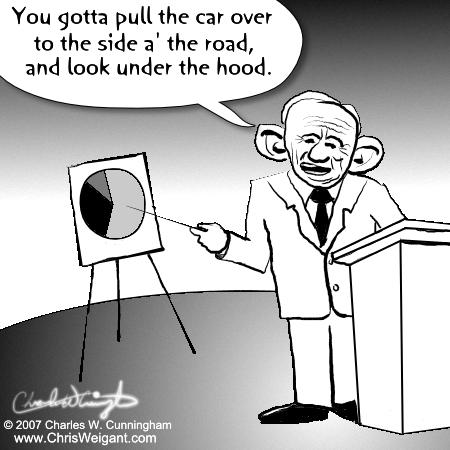
from IBD
Put Cap-And-Trade In The Trunk, Where It Can't Cause Any Trouble
When running for president, Ross Perot began a discussion of major problems by saying we have to "look under the hood."
That's simple but smart advice. And with House Democrats releasing a draft climate bill earlier this week, it's time for lawmakers and the U.S. public to "look under the hood" of cap-and-trade.
Aimed at reducing our country's greenhouse gas emissions, a cap-and-trade policy is well-intentioned.
However, advocates of the regulation seem to hide behind those good intentions as a way to deflect serious questions about the policy's "caps": The rationale for setting specific emissions levels, the practicality of getting them right, and the possible costs of getting them wrong.
Take for instance, the cap-and-trade system outlined in the draft bill released by House Energy and Commerce Committee Chairman Henry Waxman last week. It calls for a 20% reduction in U.S. greenhouse-gas emissions by 2020.
Since emissions are mostly generated from energy use (heating your home, cooling your groceries, driving to work, etc.), these targets would effectively mandate energy rationing.
Moreover, these targets are not based on economic or technological realities.
The 2020 emissions cap proposed in the House bill is not based on scientific fact and rigorous analysis. Instead, this kind of hard cap is the product of political rhetoric.
The factors that lawmakers would have to know in order to effectively set emissions caps are essentially unknowable right now (and for much of the period covered by Waxman's legislation). Since emissions are the result of fossil fuel use and land use changes, setting realistic caps requires a comprehensive knowledge of all the factors that influence energy and land use. These include:
• Changes in population, age distribution, and family size;
• population density and distribution;
• economic growth rates and the mix of economic activities;
• the mix of energy sources, energy prices, the growth in nuclear power and alternative energy;
• the mix of transportation vehicles;
• technological advances and breakthroughs and the rate at which new or existing technologies are adopted; and
• the turnover of the nation's capital stock.
Some factors like population growth and energy prices can be estimated reasonably well over the short term. However, as the planning horizon moves further away, the ability to accurately assess all of these factors diminishes greatly.
The probability of knowing most of them well enough to set realistic caps is — statistically speaking — zero. If these factors cannot be known reasonably well for 2020, those for 2050 are idle speculation.
Mere speculation is hardly a good basis for policy mandates.
The presumption of sufficient knowledge for central planning is not new.

It's what Nobel laureate Friedrich Hayek termed the "fatal conceit." There is no historical evidence that any government has ever planned a major economic intervention that worked as planned, even with mid-course corrections.
The failed oil and price allocation system of the 1970s clearly demonstrates the futility of such attempts.
Inevitably, well-intentioned bureaucratic interventions have unintended consequences that prove economically disruptive and damaging.
In the case of emissions caps, Congress would have to find ways to not only avoid the growth in emissions from now to 2020 projected by standard economic models; lawmakers would also have to reduce emissions below the 2005 level, while simultaneously promoting healthy economic growth.
That's no small feat.
The Energy Information Administration's Energy Outlook projects that CO2 emissions — the primary greenhouse gas — will be over six gigatons in 2020.
And that estimate has been reduced to reflect recent energy legislation and lower economic growth.
Achieving a 15% to 20% reduction from the 2005 level of about 5.9 gigatons means that over the next 21 years, ways would have to be found to eliminate one gigaton or more of CO2.
To judge how practical that is, a one-gigaton reduction is the equivalent of doubling the miles per gallon of all light duty vehicles on the road.
Recent legislation mandating an increase in Corporate Average Fuel Economy, CAFE, standards requires average miles per gallon to be 35 by 2020.
Although there will be a complete turnover of the auto fleet by 2030, it is not likely that the average on-road mpg will double.
Additional reductions would have to come from the power generation sector.
A one-gigaton reduction there is the equivalent of building 136 new nuclear plants or 273 zero-emission coal-fired plants.
You'd be hard-pressed to find anyone who believes that magnitude of construction is likely.
That being the case, it's important to ask: Where will the needed reductions come from?
If the White House and Congress are unable to provide a clear and convincing answer, the policy simply is not ready to pass.

The current economic pain that we are experiencing and the good intentions that contributed to it should be a lesson to tread more carefully and — every so often — to take a good look under the hood.
O'Keefe, chief executive officer of the Marshall Institute, is president of Solutions Consulting Inc.
No comments:
Post a Comment